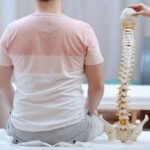Benefits of Chiropractic | MRI scans are used across all medical professions to find out what is going on inside the body. It is much in the same way as an X-ray or an ultrasound. Each different type of imaging is a form of investigation and is suitable for various issues and diagnoses. For example, X-rays are useful to look for bone fractures, and ultrasound is commonly used during pregnancy to check the growth of the baby. Chiropractors often use an MRI because it shows soft tissues as well as bones and it shows the benefits of chiropractic.
Benefits of Chiropractic | When X-ray is not Enough: Ordering MRI for Chiropractic Patients
At first glance, the patient’s lower back pain seemed uncomplicated. Still, there was something uncanny about the case for Steven Saro, DC, of the Saro Chiropractic Health Center 40 miles north of Boston in Dracut, MA. He decided to order an MRI and found the patient had a sizeable tumor on the spinal cord.
“It probably did save that patient’s life, but without the imaging, we would not have found it,” says Dr. Saro.
Chiropractors often order MR imaging when they want to investigate disc herniations, malalignment of bones, or soft tissue injuries. “MRI gives a lot of information, especially for the back, which is what chiropractors are interested in,” says Stephen Karshbaum, MD, a CDI radiologist who has been reading MR scans for more than 20 years. Dr. Karshbaum says MRI shows more of the acute or chronic illness of the injury because when something is acutely injured, it has a lot of fluid and bone marrow. “We can give some essential information with MR imaging that we can’t with X-ray. I believe that it helps chiropractors change their treatment plans.”
Uses of MRI Scan
It’s typically low back and leg pain, neck, and arm pain, or headaches that lead people to Dr. Saro for treatment. An X-ray can be a good starting point, but sometimes additional information is needed that you can’t get from an X-ray. Typically, the benefits of chiropractic are the next step for these reasons:
- Exclude fracture
- To look for tumors
- Look for dislocations
- To look for aneurisms
The difference between X-ray and MR images, he says, is like the difference between watching TV in black and white versus in color.
“Typically, if we have an MRI on any patient, it covers everything,” says Dr. Saro. “Nothing’s going to be missed. You still have to manage the person appropriately. But MRI is the gold standard, in my opinion.”
Even though MRI provides so much more detail, Dr. Saro estimates that he eventually send only five to 10-percent of his patients for MRI scans. At his practice, he’s developed a standard of care to determine who needs an MRI and who doesn’t.
Benefits of Chiropractic | Establishing an imaging standard of care
Patients who benefits of chiropractic fit into what Dr. Saro calls his algorithm to help determine what kind of images will be most useful in their care plan. Most start with X-rays and then go through three to four weeks of treatment. He expects a 50-percent objective improvement in those three to four weeks. If a patient isn’t progressing the way he expects, then an MRI is the next step. The pictures he gets from an MR aren’t a “panacea,” says Dr. Saro, but they do help guide the management of patients who aren’t responding as expected.
When a patient needs an MRI, Dr. Saro orders it from the Center for Diagnostic Imaging (CDI). The free-standing imaging centers are straightforward for his patients to navigate and spare them the confusion of trying to find the imaging department within one of his local hospitals. He says the reports he gets back from his patients about the care they receive from the CDI team are so positive that he continues to refer more of his patients there.
What is an MRI Scan?
MRI stands for Magnetic Resonance Imaging and uses magnetic fields to create images of the body. For this reason, it can be more effective than an x-ray and doesn’t use any radiation.
Because an MRI scanner produces detailed images of the body, it can be beneficial in diagnosing conditions and allowing practitioners to treat issues effectively hence, the benefits of chiropractic. MRI scans can display any part of the body, but they are often used to examine the brain, breasts, internal organs, or spinal cord. MRI scans are one of the safest medical forms of imaging currently available, and it is a painless procedure. However, most MRI scanners are long tubes, and patients need to lay down for an extended period. People who have claustrophobia may find the scan uncomfortable.
Why would a chiropractor refer me for an MRI scan?
An MRI is a longer and more complicated procedure than an X-ray, but it may be necessary to see the soft tissues in the back. MRI scans are options to assess problems with the joints and surrounding muscles and ligaments as well as the discs of the spine.
If a chiropractor thinks you have a suspected disc issue, which could be the cause of your back pain, they may request an MRI scan to confirm this is the case. A prolapsed disc is a disc that is out of place and putting pressure on a nerve. It is challenging to diagnose without seeing the shape and placement of the vertebrae inside the back. Chiropractors can recommend an MRI scan before they offer chiropractic treatment to make sure they will be able to help you and relieve the pain.
Benefits of Chiropractic | MRI research
Research helps to explain why chiropractic is so useful for low-back pain. Using MRI scans, researchers were able to document the immediate benefits of chiropractic adjustments. Patients with low-back pain have restricted mobility in the lumbar spine that results in degenerative changes and fibrous adhesions within the joints of the vertebrae. Researchers hypothesized that chiropractic adjustments increase gapping between the joints of the vertebrae, which breaks up adhesions and allows the limbs to move freely.
In a new study, the researchers randomly assigned 112 patients with low-back pain to receive either chiropractic adjustments, side-posture positioning, or two control treatments. Immediately after the treatment, they received an MRI scan that allowed researchers to analyze spinal gapping.
The chiropractic patients had the most substantial spinal gapping, and patients treated with a combination of chiropractic adjustments and side-posture positioning had the most considerable reduction in pain. This study shows the benefits of chiropractic, how chiropractic can restore spinal health to decrease disability and pain.
Reference:
Cramer GD, et al. Magnetic resonance imaging zygapophyseal joint space changes (gapping) in low back pain patients following spinal manipulation and side-posture positioning: a randomized controlled mechanisms trial with blinding.
A 2019 study showed that low back pain sufferers who engaged in Chiropractic adjustments experienced a significant reduction in pain. MRI findings also revealed that the same subjects experienced improved brain chemistry levels. Researchers split a group of low back pain sufferers in half and evaluated the benefits of Chiropractic adjustments compared to a placebo adjustment. The control group experienced a placebo (fake) correction to ensure that the control and variable groups remained unaware of who belonged to each group. The placebo adjustment group ultimately experienced no significant changes.
Back pain comprises the single leading cause of disability worldwide
Backache comprises the single leading cause of disability worldwide preventing many people from engaging in work and other everyday activities. It also represents one of the most common reasons for missed work. Half of all working Americans admit to having back pain symptoms each year. Experts estimate that up to 80% of the population will experience back pain at some point in their lives. Back pain affects people of all ages, from adolescents to the elderly. Low back pain results in the third most common reason for visits to the doctor’s office, behind skin disorders and osteoarthritis. These people mostly benefits of chiropractic treatment.
Care for back pain comes at a tremendous cost. Back pain costs Americans at least $50 billion in health care expenses each year. Calculating lost wages and decreased productivity raises that figure to more than $100 billion. These significant statistics require a solution that addresses both root causes and methodology that produces proper healing. The most common medicinal method for treating low back pain involves the consumption of NSAID (non-steroidal anti-inflammatories) and opioid drugs. These medications never address the root cause of low back pain and come bearing dangerous side effects. Opioid addiction ravages families and currently represents one of America’s most detrimental epidemics.
Chiropractic spinal adjustments produce healing results
Adjustments accompany evidence-based research highlighting functional improvements in the body far beyond typical back pain relief. The spine and nervous system regulate healing and performance. A properly operating nervous system improves brain function and many other aspects of health. The 2019 study proved that the benefits of chiropractic may have produced low back pain relief but extended far beyond pain relief and range of motion.
The results of the research also showed significant improvements in brain metabolites for the group who received a Chiropractic adjustment. The results of the study determined that patients suffering from chronic low back pain who engaged in consecutive weeks of Chiropractic adjustments experienced significant relief from pain and functional disability. Science and research continue to broadcast what Chiropractors have witnessed in patients for over 100 years benefits of chiropractic. Spinal care provides healing outcomes at the source of pain and injury. Back pain represents one of the many symptoms that encounter relief and healing through the natural care available through Chiropractic care, benefits of chiropractic.
Irish Journal of Medical Science November 2019
“The effect of spinal manipulation on brain neurometabolites in chronic nonspecific low back pain patients: a randomized clinical trial.”
D Didehdar, F Kamali, AK Yoosefinejad, M Lotfi








